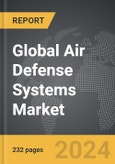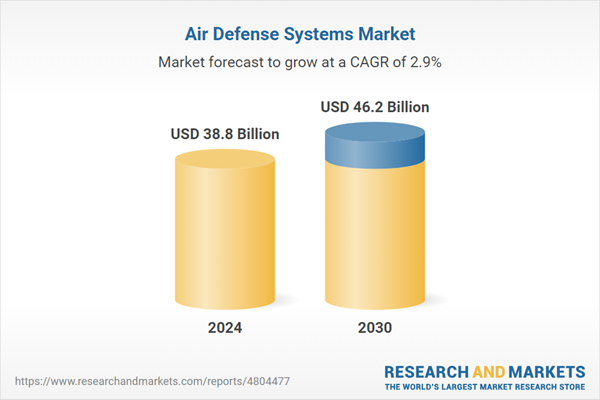The global market for Air Defense Systems was valued at US$38.8 Billion in 2024 and is projected to reach US$46.2 Billion by 2030, growing at a CAGR of 2.9% from 2024 to 2030. This comprehensive report provides an in-depth analysis of market trends, drivers, and forecasts, helping you make informed business decisions. The report includes the most recent global tariff developments and how they impact the Air Defense Systems market.
Segments: Type (Missile Defense Systems, Anti-Aircraft Systems, C-Ram Systems); Platform (Land, Naval, Airborne).
Geographic Regions/Countries: World; United States; Canada; Japan; China; Europe (France; Germany; Italy; United Kingdom; Spain; Russia; and Rest of Europe); Asia-Pacific (Australia; India; South Korea; and Rest of Asia-Pacific); Latin America (Argentina; Brazil; Mexico; and Rest of Latin America); Middle East (Iran; Israel; Saudi Arabia; United Arab Emirates; and Rest of Middle East); and Africa.
The analysts continuously track trade developments worldwide, drawing insights from leading global economists and over 200 industry and policy institutions, including think tanks, trade organizations, and national economic advisory bodies. This intelligence is integrated into forecasting models to provide timely, data-driven analysis of emerging risks and opportunities.
Global Air Defense Systems Market - Key Trends and Drivers Summarized
What Are Air Defense Systems and How Do They Function?
Air defense systems are comprehensive arrays of military technologies and strategies designed to detect, track, intercept, and neutralize airborne threats such as aircraft, missiles, and unmanned aerial vehicles (UAVs). These systems typically consist of radar and sensor networks, command and control centers, and various types of interceptors including surface-to-air missiles and anti-aircraft artillery. The radar and sensor networks play a crucial role in the early detection of threats, providing continuous surveillance and data to the command centers. Once a potential threat is identified, the command and control systems analyze the data, prioritize the threats, and coordinate the deployment of interceptors to neutralize them. The effectiveness of air defense systems relies on the seamless integration of these components, enabling a rapid and accurate response to any airborne threat, thereby protecting national airspace and critical infrastructure.Why Are Air Defense Systems Essential in Modern Warfare?
In the context of modern warfare, air defense systems are indispensable due to the increasing sophistication and variety of aerial threats. The advent of advanced missile technology, stealth aircraft, and UAVs has made traditional air defense methods obsolete, necessitating the development of more advanced and integrated systems. Air defense systems provide a multi-layered defense mechanism, capable of addressing threats at various altitudes and ranges, from short-range tactical missiles to long-range ballistic missiles. These systems are also crucial for maintaining air superiority and ensuring the safety of ground forces and civilian populations. Furthermore, the ability to rapidly detect and intercept threats enhances a nation's deterrence capabilities, dissuading potential aggressors from launching aerial attacks. In addition to military applications, air defense systems are increasingly being utilized for homeland security, protecting critical infrastructure such as nuclear power plants, government buildings, and major urban centers from potential aerial threats.How Are Technological Innovations Shaping the Future of Air Defense Systems?
Technological innovations are continuously enhancing the capabilities and effectiveness of air defense systems. Advances in radar and sensor technologies, including the development of active electronically scanned arrays (AESA) and multi-spectral sensors, are significantly improving the detection and tracking of stealthy and high-speed targets. Artificial intelligence (AI) and machine learning are being integrated into command and control systems to enhance threat analysis and decision-making processes, enabling faster and more accurate responses. Additionally, the development of directed energy weapons, such as high-energy lasers, is providing new methods for intercepting and neutralizing threats. Hypersonic missile defense is another area of significant research and development, focusing on countering the emerging threat posed by missiles that travel at speeds exceeding Mach 5. These technological advancements are not only improving the performance and reliability of air defense systems but also expanding their capabilities to address a broader range of threats.What Factors Are Driving Growth in the Air Defense Systems Market?
The growth in the air defense systems market is driven by several factors reflecting technological advancements, evolving threat landscapes, and increased defense spending. One major driver is the rising geopolitical tensions and military conflicts worldwide, which are prompting nations to invest heavily in advanced air defense systems to safeguard their airspace and deter potential aggressors. Technological advancements in radar, sensor, and missile technologies are also propelling market growth by providing more effective and versatile defense solutions. The increasing threat posed by UAVs and hypersonic missiles is further driving demand for sophisticated air defense systems capable of countering these advanced threats. Additionally, the expansion of defense budgets in many countries, particularly in Asia-Pacific and the Middle East, is generating significant opportunities for market growth. Government regulations and international defense collaborations are also supporting the adoption and deployment of modern air defense systems. As these factors converge, the air defense systems market is poised for robust growth, driven by continuous innovation and the escalating need for enhanced national security measures.Report Scope
The report analyzes the Air Defense Systems market, presented in terms of units. The analysis covers the key segments and geographic regions outlined below.Segments: Type (Missile Defense Systems, Anti-Aircraft Systems, C-Ram Systems); Platform (Land, Naval, Airborne).
Geographic Regions/Countries: World; United States; Canada; Japan; China; Europe (France; Germany; Italy; United Kingdom; Spain; Russia; and Rest of Europe); Asia-Pacific (Australia; India; South Korea; and Rest of Asia-Pacific); Latin America (Argentina; Brazil; Mexico; and Rest of Latin America); Middle East (Iran; Israel; Saudi Arabia; United Arab Emirates; and Rest of Middle East); and Africa.
Key Insights:
- Market Growth: Understand the significant growth trajectory of the Missile Defense Systems segment, which is expected to reach US$21.7 Billion by 2030 with a CAGR of a 3.4%. The Anti-Aircraft Systems segment is also set to grow at 2.4% CAGR over the analysis period.
- Regional Analysis: Gain insights into the U.S. market, valued at $10.4 Billion in 2024, and China, forecasted to grow at an impressive 5.4% CAGR to reach $9.4 Billion by 2030. Discover growth trends in other key regions, including Japan, Canada, Germany, and the Asia-Pacific.
Why You Should Buy This Report:
- Detailed Market Analysis: Access a thorough analysis of the Global Air Defense Systems Market, covering all major geographic regions and market segments.
- Competitive Insights: Get an overview of the competitive landscape, including the market presence of major players across different geographies.
- Future Trends and Drivers: Understand the key trends and drivers shaping the future of the Global Air Defense Systems Market.
- Actionable Insights: Benefit from actionable insights that can help you identify new revenue opportunities and make strategic business decisions.
Key Questions Answered:
- How is the Global Air Defense Systems Market expected to evolve by 2030?
- What are the main drivers and restraints affecting the market?
- Which market segments will grow the most over the forecast period?
- How will market shares for different regions and segments change by 2030?
- Who are the leading players in the market, and what are their prospects?
Report Features:
- Comprehensive Market Data: Independent analysis of annual sales and market forecasts in US$ Million from 2024 to 2030.
- In-Depth Regional Analysis: Detailed insights into key markets, including the U.S., China, Japan, Canada, Europe, Asia-Pacific, Latin America, Middle East, and Africa.
- Company Profiles: Coverage of players such as Aselsan A.S., BAE Systems PLC, Hanwha Corporation, Israel Aerospace Industries (IAI), Jsc Concern Vko Almaz-Antey and more.
- Complimentary Updates: Receive free report updates for one year to keep you informed of the latest market developments.
Some of the 13 companies featured in this Air Defense Systems market report include:
- Aselsan A.S.
- BAE Systems PLC
- Hanwha Corporation
- Israel Aerospace Industries (IAI)
- Jsc Concern Vko Almaz-Antey
- Kongsberg Gruppen ASA
- Leonardo SpA
- Lockheed Martin Corporation
- MBDA UK Limited
- Northrop Grumman Corporation
- Raytheon Company
- Rheinmetall AG
- SAAB AB
- Thales Group
- The Boeing Company
Tariff Impact Analysis: Key Insights for 2025
Global tariff negotiations across 180+ countries are reshaping supply chains, costs, and competitiveness. This report reflects the latest developments as of April 2025 and incorporates forward-looking insights into the market outlook.The analysts continuously track trade developments worldwide, drawing insights from leading global economists and over 200 industry and policy institutions, including think tanks, trade organizations, and national economic advisory bodies. This intelligence is integrated into forecasting models to provide timely, data-driven analysis of emerging risks and opportunities.
What’s Included in This Edition:
- Tariff-adjusted market forecasts by region and segment
- Analysis of cost and supply chain implications by sourcing and trade exposure
- Strategic insights into geographic shifts
Buyers receive a free July 2025 update with:
- Finalized tariff impacts and new trade agreement effects
- Updated projections reflecting global sourcing and cost shifts
- Expanded country-specific coverage across the industry
Table of Contents
I. METHODOLOGYII. EXECUTIVE SUMMARY2. FOCUS ON SELECT PLAYERSIII. MARKET ANALYSISSOUTH KOREAREST OF ASIA-PACIFICARGENTINABRAZILMEXICOREST OF LATIN AMERICAIRANISRAELSAUDI ARABIAUNITED ARAB EMIRATESREST OF MIDDLE EASTIV. COMPETITION
1. MARKET OVERVIEW
3. MARKET TRENDS & DRIVERS
4. GLOBAL MARKET PERSPECTIVE
UNITED STATES
CANADA
JAPAN
CHINA
EUROPE
FRANCE
GERMANY
ITALY
UNITED KINGDOM
SPAIN
RUSSIA
REST OF EUROPE
ASIA-PACIFIC
AUSTRALIA
INDIA
LATIN AMERICA
MIDDLE EAST
AFRICA
Companies Mentioned (Partial List)
A selection of companies mentioned in this report includes, but is not limited to:
- Aselsan A.S.
- BAE Systems PLC
- Hanwha Corporation
- Israel Aerospace Industries (IAI)
- Jsc Concern Vko Almaz-Antey
- Kongsberg Gruppen ASA
- Leonardo SpA
- Lockheed Martin Corporation
- MBDA UK Limited
- Northrop Grumman Corporation
- Raytheon Company
- Rheinmetall AG
- SAAB AB
- Thales Group
- The Boeing Company
Table Information
| Report Attribute | Details |
|---|---|
| No. of Pages | 250 |
| Published | April 2025 |
| Forecast Period | 2024 - 2030 |
| Estimated Market Value ( USD | $ 38.8 Billion |
| Forecasted Market Value ( USD | $ 46.2 Billion |
| Compound Annual Growth Rate | 2.9% |
| Regions Covered | Global |









